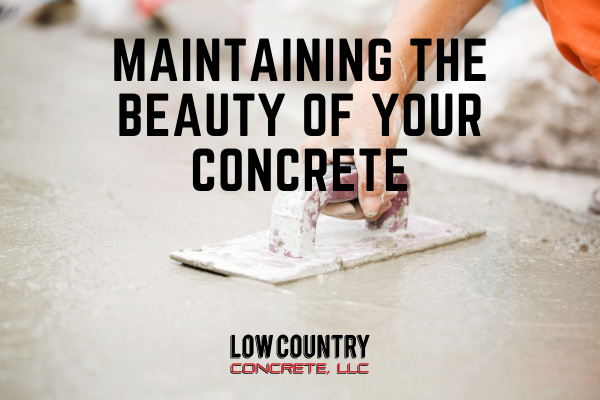For homeowners and property managers, ensuring the longevity and beauty of your concrete is not only an investment in aesthetics but also a commitment to the structural integrity of your property.
As fall settles in and winter looms on the horizon, it’s time to turn our attention to the maintenance of our outdoor spaces, particularly our concrete surfaces. Though the harsh winters people experience up north are a far cry from the mild change in seasons we see in the Lowcountry, let’s explore practical tips for caring for and maintaining your concrete surfaces during the colder months.
Sealing: A Shield Against the Elements
Why Seal Your Concrete?
Concrete, though durable, is not impervious to the elements. Rain, snow, and fluctuating temperatures can take a toll on its surface over time. Sealing your concrete serves as a protective barrier, preventing water, ice, and de-icing chemicals from penetrating the material and causing damage.
When to Seal:
Fall is an ideal time to apply a fresh coat of sealant. The moderate temperatures allow for optimal curing, ensuring that the sealer bonds effectively with the concrete. Before sealing, cleaning the surface thoroughly to remove any dirt or debris is crucial.
How to Seal:
- Clean the Surface: Use a pressure washer or a stiff brush to remove dirt, mold, and stains from the concrete surface. Pay attention to corners and edges where debris tends to accumulate.
- Fill Cracks and Joints: Inspect the concrete for any cracks or gaps before sealing. Fill these areas with an appropriate concrete filler to ensure a smooth and even surface.
- Choose the Right Sealer: Various sealers are available, including penetrating and topical sealers. Consult with Low Country Concrete or a professional to determine the best type of sealer for your specific needs.
- Apply Evenly: Use a roller or sprayer to apply the sealer evenly across the surface. Ensure that the entire area is covered, and allow the sealer to dry completely before exposing the concrete to foot traffic.
Cleaning: Banishing Stains and Grime
Preventive Cleaning:
Regular cleaning is key to maintaining the aesthetic appeal of your concrete surfaces. Leaves, dirt, and other debris can accumulate over time, leading to stains and discoloration. Sweep or blow leaves away regularly, especially in the fall when leaves are abundant.
Stain Removal:
- Oil Stains: For oil stains, apply an absorbent material like cat litter to soak up the oil. Once absorbed, sweep or vacuum away the litter. Treat any remaining stains with a mixture of baking soda and water.
- Mold and Mildew: Use a mixture of one part vinegar to three parts water to clean mold or mildew. Scrub the affected areas with a stiff brush and rinse thoroughly.
- Rust Stains: Rust stains can be challenging. A commercial rust remover or a mixture of lemon juice and salt can be applied to the affected area. Scrub gently and rinse well.
Addressing Common Issues: Cracks and Damage
Inspect for Cracks:
Before the winter months set in, inspect your concrete surfaces for any visible cracks. Cracks can worsen during freeze-thaw cycles, allowing water to penetrate and cause further damage.
Crack Repair:
- Clean the Crack: Use a wire brush or a pressure washer to clean out the crack. Remove any loose debris or particles.
- Apply Concrete Filler: Fill the crack with a high-quality concrete filler. Smooth the surface with a putty knife, ensuring an even and level finish.
- Seal the Repaired Area: Once the filler has cured, seal the repaired area along with the entire surface for added protection.
Seasonal Maintenance Checklist
As fall transitions into winter, here’s a comprehensive checklist to guide you through the seasonal maintenance of your concrete surfaces:
Fall Maintenance:
- Clean the Surface: Remove leaves, dirt, and debris from the concrete regularly.
- Inspect for Cracks: Identify and repair any visible cracks before winter.
- Seal the Surface: Apply a fresh coat of sealer to protect the concrete from winter elements.
Winter Maintenance:
- Snow and Ice Removal: In the rare event snow sticks around here in the Lowcountry, use a plastic shovel to remove snow. Avoid metal shovels, as they can damage the surface. Use ice melt sparingly and choose a product that is safe for concrete.
- Avoid De-Icing Chemicals: Refrain from using harsh de-icing chemicals, which can damage the concrete over time.
- Protect Edges and Corners: Be cautious when shoveling to avoid chipping or cracking the edges and corners of the concrete.
Pave the Way to Ensuring Your Concrete is Maintained During Fall and Winter
By following these maintenance tips and staying proactive in caring for your concrete surfaces, you not only enhance your property’s visual appeal but also extend your concrete’s life and durability. For more personalized advice or assistance, reach out to Low Country Concrete, your trusted partner in concrete solutions. Winter may be coming, but with the proper care, your concrete can withstand the chill while maintaining its timeless beauty.


Recent Comments